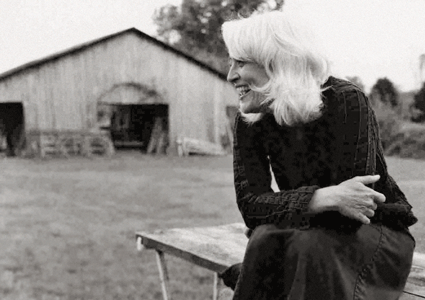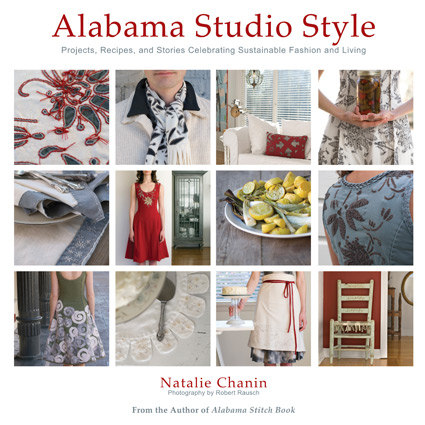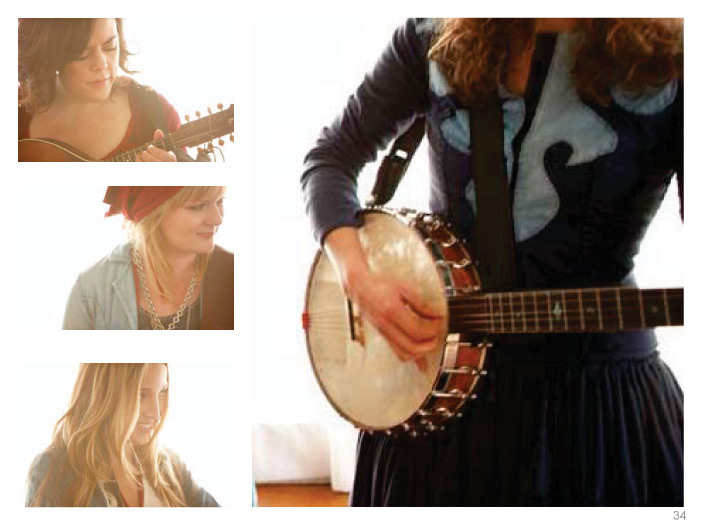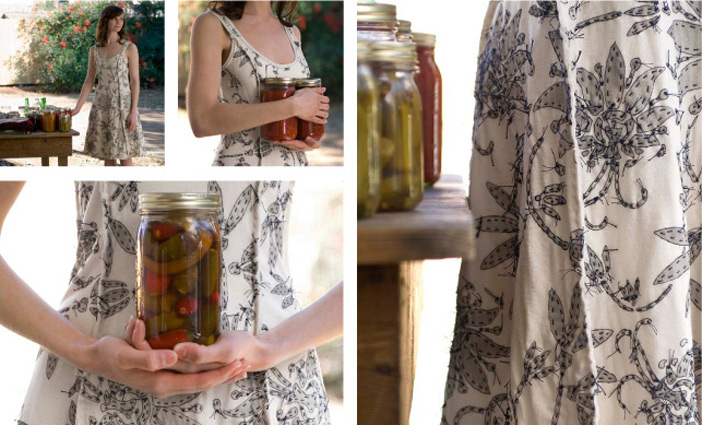Alabama Studio Style

I'm thrilled today to welcome Natalie Chanin, the brilliant mind and nimble, patient hands behind the Alabama Chanin label and the new book Alabama Studio Style, from STC Craft. Natalie's broad range of work and utterly unique vision have had a substantial impact on both the industry of high fashion and the crafts market. She has been celebrated by Vogue Magazine, Nashville's music legends, mind reading chickens, pickle recipe collectors, and just about every spot in between.
HR: Natalie, Welcome! I met you a few years ago. I walked into your temporary showroom near Union Square, you were launching a new collection in a lovely loft space and had hired a bluegrass band to play and brought your studio chef up to cook. I was fasting at the time,(bad idea overall) but thought I was pretty safe going to a fashion event having not eaten for three days, usually its just lots of skinny people and bad, small, evil hors d'oeuvres. I walked in and saw that amazing long wooden table, stretching half the length of the room, covered with all of that beautiful home-made delicious food! I remember thinking: “With every other designer and celebrity out there trying to leverage and license themselves into becoming “lifestyle brands”, this woman is instead making a way of life. And dinner for fifty.” Then I started crying, went into the coat closet, and called my husband and told him to find somebody else to do the Master Cleanse with, I was out. Then I grazed my way up and down your buffet. Tell me about these launch events, and about how it feels to bring your work, your food, and your vision out of Alabama and into places like New York City. What do you want people to see? To hear? To notice on their own?
NC: That was such a beautiful night and how wonderfully you recreate the mood. I am honored and happy that you saw the work as a way of life. You know, I am a hostess and story teller at heart. I love to have dinner parties, events brunches and such but it is always wonderful when the dinner or event has a story to tell as well.
And better, when the story can set the stage for people to tell and make new stories. It is wonderful when a guest – like you – really gets it. And I guess that this is the same rush that you can get with design – when someone really appreciates the work that you have done and finds it compelling, beautiful or disturbing – any emotion will do.
These events – like the books – are an extension of me. I want you to feel like you have just sat down at my table, eaten a luscious meal, heard delicious stories, laughed, smiled and are headed home feeling enriched, satisfied and refreshed. This is what I strive for and if it comes across at a party or when you sit down with the books then I feel joy.

HR: Naturally, I was thrilled to see that your new book has recipes. Can you tell me about what food means to your work, and to your workplace?
AC: My world is so connected to food. The Slow Design movement takes its credo from the Slow Food International: Good, Clean, Fair. These are good rules for running a company or your home kitchen. I am an avid gardener, cook and am really happiest when I am in the kitchen, music playing and preparing something I just pulled out of my garden plot.
You know, I believe that my industry – the fashion industry that you mention above – could learn a lot from the food industry. Perhaps sitting down for a good meal should be the beginning of every show!
HR: When your first book came out I showed it to all of my students at Patchwork in Soho. Most of them, being good New Yorkers, already knew about your work via Barneys. They couldn’t believe that you had published step by step instructions that would enable them to make a blouse or a skirt that would cost them thousands of dollars at a store just a few blocks away. I explained to them my own theory, that this was a sign of a company and a designer with a lot of integrity. The corset, for example, costs what it costs because the time and skill of the person making it are being honored and respected, and if you buy the book and make the corset yourself, then your time and your skills are being honored too, and rewarded with a very valuable and personal article of clothing. You also host workshops, where your techniques and methods are taught and shared. Tell me about your decision to include your most coveted designs and patterns in your books. What’s behind it?
AC: This is a really interesting question and at the core of my work at Alabama Chanin and the answer is not an easy one.
The only complaint we have ever received as a company is about the cost of our garments. What’s funny is that once you actually make one, you really understand why they are worth so much. At the same time, I realized along the way that these traditions were dying in my community and communities all over the nation. Consequently, it became one of my missions to collect stories and techniques and work towards not only incorporating them in my work but using that work as a means towards cultural preservation.
In the end, I simply found that making something with my own two hands added to the value of that object in my life. Does that make sense? In essence, making brings added meaning. And our clients for the couture garments understood/understand that added meaning.
These factors combined made me embrace this notion of open-sourcing. As you mention, our garments are hand-sewn in America and very expensive. In fact, many of our garments wind up in museums and private collections. If people cannot afford to purchase our garments, we offer our best-selling patterns in our books so they can make the garments themselves – or pay someone in their own communities to make them. We sell the fabrics and the supplies to make those garments. And if a client wants to shorten the steps, we offer DIY Kits that simplify the process.
This philosophy is unprecedented in the global fashion industry today and I am proud that Alabama Chanin has chosen to take this route. And honestly, it was a very difficult (and scary) decision to make and was not met with positive feedback from my industry colleagues.
However, looking at my decision today, I know absolutely that it was the right one. I could never have guessed how this small decision would bring so much beauty to my life.
 images from Natalie's "Songbirds" collectionHR: I loved your Songbirds collection. Lately I have been trying to channel Lucinda Williams when I shop for clothing. I saw her play a few years ago and she had on these amazing leather pants, with wildflowers tooled into them along the out-seams. Obviously leather pants are out for me, but I do often ask myself, while in the dressing room, would Lucinda wear this? Can you tell us about how the Songbirds idea began, and how it became a reality? And, what songs did you listen to while you were working on the collection?
images from Natalie's "Songbirds" collectionHR: I loved your Songbirds collection. Lately I have been trying to channel Lucinda Williams when I shop for clothing. I saw her play a few years ago and she had on these amazing leather pants, with wildflowers tooled into them along the out-seams. Obviously leather pants are out for me, but I do often ask myself, while in the dressing room, would Lucinda wear this? Can you tell us about how the Songbirds idea began, and how it became a reality? And, what songs did you listen to while you were working on the collection?
AC: I love that method; may I adopt it for getting dressed every morning? In fact, Lucinda was on the playlist that inspired Songbirds…
At the time of Songbirds, I found my day-to-day life filled with music and musicians in so many ways. One of the defining moments came when Allison Moorer (an amazing designer and sewer aside from being a Grammy nominated artist) came down to Alabama to attend one of our Weekend Workshops. Sunday morning – while we were all having breakfast together, she picked up her guitar, sat down on a stool and played Alabama Song for me. I could not stop crying. It was the most beautiful thing I had ever heard. That weekend formed the collection.
I started dreaming of songs and singers shortly afterwards… Emmy, Lucinda Williams, Allison Moorer, Gillian Welch, Abigail Washburn, Elizabeth Cooke, Patty Griffin, Sam Parton from the The Be Good Tanyas, the list goes on and on…
Finally, Traci Thomas, a dear friend in Nashville who works in that industry, arranged for me to meet so many of these women who so inspire me every day. The collection was born as a tribute to song.
HR: I grew up in the country, too. We were forever making and fixing things without the benefit of easily being able to get to a fabric or hardware store, and I think I see a lot of that in your “studio style”. So, play along with me. You are wearing the beautiful “Inked and Quilted Camisole Dress” from page 119. (Insert names of women you greatly admire here) are coming over for brunch in one hour and you have just splattered beet juice all over the front of your dress. You have one hour to disguise, alter, or celebrate the stains, using ONLY the tools, notions, and fabrics that are on your worktable at this very moment. OK Go.
AC: Remove the dress, splatter (or dip) the whole dress in beet juice (or red wine), dry and wear.
 Inked and Quilted Camisole Dress, page 119
Inked and Quilted Camisole Dress, page 119
